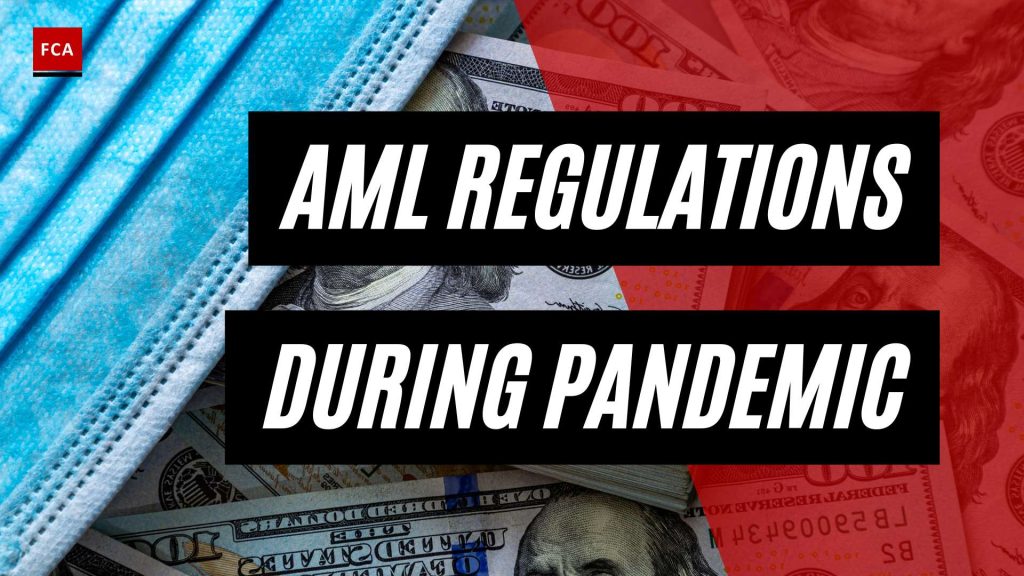AML Regulations During the COVID-19 Pandemic
The COVID-19 pandemic has had a significant impact on anti-money laundering (AML) efforts worldwide. Jurisdictions and regulatory bodies have provided guidance and implemented measures to address the challenges faced by compliance professionals during these unprecedented times.
Impact on AML Efforts
The pandemic has highlighted vulnerabilities within AML and countering the financing of terrorism (CFT) systems. Decreased face-to-face interactions and the rapid shift to remote operations have created opportunities for criminals to exploit financial systems. This has led to an increased risk of illegal financial activities, including fraud, scams, and cybercrime.
Financial institutions and authorities have had to adapt their AML operations to ensure the ongoing detection and prevention of illicit financial activities. Enhanced monitoring and due diligence processes have become crucial in identifying and mitigating emerging risks. Despite these challenges, compliance professionals have also seen opportunities for improvement in AML programs, with a greater emphasis on the use of data analytics, automation, and machine learning to enhance efficiency and effectiveness in detecting financial crimes (Bloomberg Law).
Challenges Faced by Compliance Professionals
Compliance professionals have encountered various challenges during the pandemic. The integration of new technologies has been critical in overcoming communication barriers and ensuring the security of remote working environments. Managing the increased risks associated with cyber threats and fraud has become a priority for compliance teams.
Moreover, regulatory guidance during the pandemic has required financial institutions to adjust their AML operations and processes. Compliance professionals have had to navigate evolving regulatory landscapes and rapidly implement necessary changes. This includes adapting to remote onboarding procedures, ensuring strong AML safeguards are maintained, and managing staff and systems remotely (FATF).
Collaboration and information sharing among stakeholders have been crucial in addressing the challenges posed by the pandemic. Financial institutions, regulators, law enforcement agencies, and international bodies have worked together to share best practices and coordinate responses to emerging AML risks.
In summary, the COVID-19 pandemic has brought about significant changes in AML regulations and compliance efforts. While compliance professionals face challenges in adapting to remote operations and managing emerging risks, the importance of maintaining effective AML programs and addressing emerging financial crime patterns remains paramount. Collaboration, regulatory guidance, and the implementation of digital transformation strategies have become key strategies in navigating AML regulations during the pandemic.
Adaptations in AML Compliance
As the COVID-19 pandemic continues to impact various industries, the field of anti-money laundering (AML) compliance has faced significant challenges. However, compliance professionals have swiftly adapted their strategies to ensure effective AML efforts.
Remote Customer Identification
One key adaptation in AML compliance during the pandemic has been the implementation of remote customer identification processes. With limited in-person interactions, financial institutions and compliance professionals have turned to digital methods to verify the identities of their customers. This includes the use of advanced technologies such as facial recognition, biometrics, and digital document verification. These remote identification measures not only help in complying with AML regulations but also ensure the safety and health of both customers and staff.
Enhanced Monitoring of High-Risk Transactions
The pandemic has brought about an increased risk of financial crime activities. Criminals have sought to exploit the vulnerabilities arising from the crisis, necessitating enhanced monitoring of high-risk transactions. Compliance professionals have implemented robust systems and technologies to detect and prevent illicit financial activities. By closely monitoring transactions that exhibit high-risk characteristics, such as large transfers, unusual patterns, or involvement of high-risk jurisdictions, institutions can identify potential money laundering and terrorism financing activities.
Digital Tools for Due Diligence
To maintain effective AML programs amidst the pandemic, compliance professionals have embraced digital tools for due diligence. These tools enable efficient and comprehensive assessment of customer backgrounds, relationships, and potential risks. By leveraging technologies such as artificial intelligence, machine learning, and data analytics, compliance professionals can enhance their ability to identify suspicious activities and mitigate financial crime risks. These digital tools provide an automated and systematic approach to conducting due diligence, reducing manual efforts and enhancing the accuracy and efficiency of the process.
In navigating AML regulations during the pandemic, compliance professionals have adapted their strategies by implementing remote customer identification processes, enhancing monitoring of high-risk transactions, and leveraging digital tools for due diligence. These adaptations have enabled institutions to maintain effective AML programs, address emerging financial crime patterns, and ensure compliance with regulatory requirements. By embracing technology and remote work, compliance professionals continue to play a vital role in safeguarding the integrity of the financial system.
Vulnerabilities and Risks
As the COVID-19 pandemic unfolded, it brought forth a range of vulnerabilities and risks within the realm of Anti-Money Laundering (AML) efforts. Compliance professionals and financial institutions had to navigate these challenges while striving to maintain effective AML programs. Let’s explore some of the key vulnerabilities and risks that emerged during this period.
Increased Financial Crime Activities
The global health crisis created optimal conditions for increased financial crime activities. Criminals exploited the volatile situation, leading to a surge in fraudulent schemes, scams, and cybercrime. For instance, there was a 667% spike in COVID-19-related spear-phishing attacks since the end of February, highlighting the heightened cyber threats faced during the pandemic. Additionally, reported cases of fraud, such as a pharmaceutical company being defrauded of millions of euros for the purchase of pandemic-related supplies, underscored the increased financial crime risks.
Exploitation of Remote Operations
The shift to remote working environments presented opportunities for criminals to exploit vulnerabilities in AML processes. Decreased face-to-face interactions and a reliance on digital communication channels made it easier for criminals to infiltrate financial systems. Compliance professionals faced challenges in ensuring effective AML controls while operating remotely (FATF). The increased use of digital platforms and online transactions created new avenues for illicit financial activities, necessitating enhanced monitoring and due diligence processes to detect and prevent money laundering and other financial crimes (Bloomberg Law).
Collaboration and Information Sharing
Amidst these vulnerabilities and risks, collaboration and information sharing emerged as key strategies for combating financial crime during the pandemic. Effective collaboration among stakeholders, including financial institutions, regulators, law enforcement agencies, and international bodies, became essential. Sharing information, best practices, and emerging threats facilitated a coordinated response to the evolving landscape of AML risks. By working together and fostering strong communication channels, stakeholders were able to identify and address emerging risks more effectively.
Understanding these vulnerabilities and risks is crucial for compliance professionals and financial institutions to adapt their AML strategies and employ robust measures to mitigate the impact of the pandemic on AML efforts. By remaining vigilant, enhancing collaboration, and leveraging technology, they can navigate the challenges posed by the global health crisis and safeguard financial systems from illicit activities.
Compliance Strategies During the Pandemic
As the COVID-19 pandemic continues to impact various industries, the field of anti-money laundering (AML) compliance has faced unique challenges. However, compliance professionals have adapted their strategies to navigate these unprecedented times. In this section, we will explore three key compliance strategies implemented during the pandemic: adjusting AML operations, regulatory guidance and collaboration, and digital transformation and remote work.
Adjusting AML Operations
Financial institutions and compliance professionals have had to make significant adjustments to their AML operations in response to the pandemic. The regulatory guidance issued worldwide, including in the U.S., UK, and Europe, has played a crucial role in shaping these adaptations.
To address the challenges posed by remote working environments, financial institutions have modified their customer risk assessments, enhanced transaction monitoring, and implemented robust cybersecurity measures to mitigate potential AML compliance risks associated with remote operations (Bloomberg Law). The focus has been on ensuring that compliance programs remain effective while adapting to the new working conditions.
Regulatory Guidance and Collaboration
During times of crisis, regulatory guidance and collaboration between financial institutions and regulatory bodies become even more critical. The COVID-19 pandemic has highlighted the importance of ongoing regulatory guidance to address emerging financial crime patterns (Bloomberg Law). Compliance professionals have closely collaborated with regulatory authorities to stay updated on changing regulations and to ensure that their AML efforts align with the latest requirements.
This collaboration has helped compliance professionals navigate the evolving landscape of AML regulations and has facilitated the sharing of best practices and industry insights. By working together, both regulators and financial institutions can address the unique challenges posed by the pandemic and strengthen their AML compliance efforts.
Digital Transformation and Remote Work
The COVID-19 pandemic has accelerated the adoption of digital technologies within AML compliance programs. Financial institutions have embraced digital transformation to facilitate remote customer onboarding, customer identification, and enhanced transaction monitoring. This shift towards digital tools and remote work has allowed compliance professionals to continue their crucial AML functions while ensuring the safety and well-being of their teams.
The movement towards a cashless economy, which has been expedited by the pandemic, has also necessitated changes in traditional AML methodology (Huron Consulting Group). Financial institutions are adapting their AML compliance strategies to account for the decrease in cash transactions and the increased focus on digital payments. This shift requires reassessing AML scenario threshold logic and implementing preventative measures such as facial recognition and machine learning signature verification to mitigate identity and signature falsification risks.
By adjusting AML operations, collaborating with regulatory bodies, and embracing digital transformation, compliance professionals are successfully navigating the challenges posed by the pandemic. These strategies enable financial institutions to maintain effective AML programs, address emerging financial crime patterns, and ensure compliance with evolving regulations (Bloomberg Law). As the pandemic continues to shape the world of AML, ongoing vigilance and adaptation will be essential to combat money laundering and terrorist financing risks effectively.
The Importance of AML Compliance
In the face of the COVID-19 pandemic, maintaining effective Anti-Money Laundering (AML) programs has become even more critical. Compliance professionals have encountered numerous challenges but have also identified opportunities for improvement. Let’s explore the importance of AML compliance and the key strategies employed during these unprecedented times.
Maintaining Effective AML Programs
Despite the disruptions caused by the pandemic, it is crucial for financial institutions and authorities to maintain robust AML programs. The COVID-19 crisis has created optimal conditions for increased financial crime activities, such as fraud, scams, and cybercrime (Eastnets). By upholding effective AML programs, institutions can mitigate the risks associated with money laundering and terrorist financing.
To address the evolving financial crime patterns, compliance professionals have focused on enhancing customer due diligence processes. This involves adapting AML operations to accommodate remote customer identification and verification, leveraging digital tools for enhanced monitoring, and ensuring compliance with regulatory requirements (Bloomberg Law). By staying vigilant and proactive, financial institutions can better detect and prevent emerging financial crime patterns.
Addressing Emerging Financial Crime Patterns
The COVID-19 pandemic has led to an unprecedented increase in cybercrimes, including ransomware and phishing attacks. There has been a staggering 667% spike in COVID-19-related spear-phishing attacks since the end of February. To address these emerging risks, financial institutions must prioritize cybersecurity measures and implement robust controls to protect their systems and customer data.
Furthermore, the pandemic has highlighted vulnerabilities within AML systems, such as the increased exploitation of remote operations. Criminals have taken advantage of decreased face-to-face interactions, making it easier for them to infiltrate financial systems (FATF). By addressing these vulnerabilities and adapting AML methodologies, institutions can effectively respond to the evolving risks associated with money laundering and financial crimes.
Industry Collaboration and Regulatory Guidance
Collaboration and communication among stakeholders have played a crucial role in navigating AML challenges during the pandemic. Financial institutions, regulators, law enforcement agencies, and international bodies have come together to share information and best practices (FATF). This collaboration has facilitated a coordinated response to AML risks, ensuring that industry-wide efforts align with regulatory guidance.
Regulatory guidance has been instrumental in helping compliance professionals adjust their AML operations. Regulators worldwide, including those in the U.S., UK, and Europe, have issued guidance specific to the pandemic, allowing financial institutions to adapt their processes and controls accordingly. By staying informed and collaborating with regulatory bodies, institutions can navigate the complexities of AML compliance during these challenging times.
By recognizing the importance of AML compliance, addressing emerging financial crime patterns, and fostering industry collaboration, financial institutions can maintain the integrity of their AML programs. The COVID-19 pandemic has accelerated the need for digital transformation and remote work, making it essential for institutions to adapt their AML methodologies accordingly. Through continuous adaptation and compliance, financial institutions can effectively protect their systems and safeguard against illicit activities.
International Perspectives on AML
In the ever-evolving landscape of anti-money laundering (AML) regulations, various countries and regions have implemented measures to combat financial crimes, including during the COVID-19 pandemic. This section explores the AML perspectives of Canada, the European Union (EU), and global efforts and collaboration.
Canada’s AML/ATF Regime
The Government of Canada continuously enhances its anti-money laundering and anti-terrorist financing (AML/ATF) Regime to address emerging risks associated with money laundering and terrorist financing. The AML/ATF framework in Canada encompasses comprehensive legislative statutes that outline the responsibilities of Regime partners and aim to combat money laundering and terrorist financing while respecting constitutional division of powers, the Canadian Charter of Rights and Freedoms, and the privacy rights of Canadians (Government of Canada).
Within the private sector, more than 24,000 Canadian businesses play a crucial frontline role in preventing and detecting money laundering and terrorist financing. These businesses comply with obligations outlined in the Proceeds of Crime (Money Laundering) and Terrorist Finance Act (PCMLTFA), contributing to the collective efforts to maintain the integrity of the financial system.
Canada actively collaborates with international organizations and key allies, such as the Financial Action Task Force (FATF), FATF-Style Regional Bodies (FSRBs), and the Egmont Group of Financial Intelligence Units (FIUs), to effectively address money laundering and terrorist financing threats (Government of Canada).
EU’s 6th Anti-Money Laundering Directive
The European Union’s (EU) 6th Anti-Money Laundering Directive (6AMLD) is the latest directive that focuses on combating money laundering by leveraging technological advancements. Introduced to strengthen the AML framework, the 6AMLD introduces new offences related to cybercrime and emphasizes greater monitoring and security measures. Its aim is to enhance the EU’s ability to prevent and detect money laundering activities.
The 6AMLD aligns with the EU’s commitment to implementing robust AML regulations and ensuring the security and integrity of the financial system. By addressing emerging challenges and harnessing technological advancements, the EU aims to stay at the forefront of AML efforts.
Global Efforts and Collaboration
Efforts to combat money laundering and terrorist financing extend beyond individual countries and regions. Collaboration among nations, international organizations, and regulatory bodies plays a crucial role in addressing global financial crime risks.
Countries, including Canada and those within the EU, collaborate with international organizations such as the Financial Action Task Force (FATF), FATF-Style Regional Bodies (FSRBs), and the Egmont Group of Financial Intelligence Units (FIUs). These collaborations facilitate the exchange of information, best practices, and regulatory guidance to effectively tackle money laundering and terrorist financing threats on a global scale.
Global efforts emphasize the importance of international cooperation and coordination to combat financial crimes. By sharing knowledge, resources, and expertise, countries can collectively strengthen their AML frameworks, enhance monitoring capabilities, and mitigate the risks associated with money laundering and terrorist financing.
Understanding the AML perspectives of different countries and regions provides valuable insights into the global fight against financial crimes. By aligning strategies, regulations, and collaboration efforts, stakeholders can work together to maintain the integrity of the financial system and protect against money laundering and terrorist financing activities.
Adapting AML Methodology
As the world undergoes a significant shift towards a cashless economy, the traditional anti-money laundering (AML) methodology must also adapt to these changing circumstances. The COVID-19 pandemic has accelerated the transition to digital financial transactions, necessitating adjustments in AML practices to effectively address emerging risks and comply with regulations. In this section, we will explore three key aspects of adapting AML methodology: the shift to a cashless economy, the digitization of Know Your Customer (KYC) verification, and leveraging technology for AML compliance.
Shift to Cashless Economy
The movement towards a cashless economy, accelerated by the pandemic, has significant implications for AML compliance. With a decrease in cash transactions, financial institutions need to adjust their AML methodology to account for this shift and ensure effectiveness in detecting and preventing money laundering activities. The scenario threshold logic used in AML systems must be modified to adapt to the changing transaction landscape, reducing false positives for legitimate transactions while addressing changes in criminal activity.
Digitization of KYC Verification
As the focus on virtual onboarding and remote customer interactions intensifies, the digitization of KYC verification processes becomes crucial. However, this shift also presents new challenges, such as the heightened risk of identity and signature falsification in the digital realm. To mitigate these risks, financial institutions are implementing preventative measures within the eKYC process, including facial recognition technology and machine learning signature verification. These technologies help prevent fraudulent activities and ensure the integrity of the KYC verification process.
Leveraging Technology for AML Compliance
The COVID-19 crisis has accelerated the adoption of technology and electronic systems to facilitate AML compliance in the face of remote work and increased online financial activities. Financial institutions are encouraged to leverage innovative technologies to enhance their AML efforts. This includes the use of advanced data analytics, artificial intelligence, and machine learning algorithms to strengthen transaction monitoring, customer due diligence, and detection of suspicious activities. Embracing these technological advancements allows financial institutions to adapt to the new operating environment while maintaining compliance with AML regulations.
By adapting AML methodology to the shift towards a cashless economy, the digitization of KYC verification, and the utilization of technology for AML compliance, financial institutions can effectively navigate the challenges posed by the pandemic. These adaptations ensure that AML efforts remain robust, enabling the detection and prevention of money laundering activities in an evolving financial landscape. It is essential for organizations to stay up-to-date with emerging trends and regulatory guidance to ensure the continued efficacy of their AML programs.
Cybersecurity and Financial Crime
As the COVID-19 pandemic continues to reshape the global landscape, the world has witnessed a surge in cyber threats and data breaches. Criminals have capitalized on the vulnerabilities presented by the pandemic, exploiting the rapid shift towards digital and remote operations. This section explores the intersection of cybersecurity and financial crime, and the measures that can be taken to protect financial systems and ensure robust cybersecurity.
Cyber Threats and Data Breaches
The COVID-19 pandemic has created optimal conditions for human exploitation, resulting in a significant increase in cybercrimes such as ransomware attacks and phishing attempts. According to Eastnets, there has been a staggering 667% spike in COVID-19-related spear-phishing attacks since the end of February. These attacks prey on the vulnerabilities and fears associated with the pandemic, targeting individuals and organizations alike.
Data breaches have also become a growing concern during the pandemic. Cybercriminals are actively seeking to exploit weaknesses in remote working setups and digital infrastructure to gain unauthorized access to sensitive information. Financial institutions and businesses must remain vigilant in implementing robust cybersecurity measures to protect against these threats and safeguard customer data.
Protecting Financial Systems
As financial institutions and authorities adapt to the digital and remote working environment, protecting financial systems from illicit activities becomes paramount. Enhanced monitoring and due diligence processes are necessary to detect and prevent money laundering, fraud, and other financial crimes.
Financial institutions should implement comprehensive risk management frameworks that encompass cybersecurity measures. This includes utilizing advanced technologies for threat detection, implementing multi-factor authentication, and employing encryption techniques to secure sensitive financial data. Regular security assessments and audits should be conducted to identify vulnerabilities and ensure ongoing protection.
Robust Cybersecurity Measures
To mitigate the risks posed by cyber threats and data breaches, financial institutions must adopt robust cybersecurity measures. These measures should include:
-
Employee Training: Providing comprehensive cybersecurity training to employees is crucial in creating a culture of security awareness. Employees should be educated on recognizing and reporting potential threats, such as phishing emails or suspicious network activity.
-
Secure Remote Access: Implementing secure remote access protocols, such as virtual private networks (VPNs), can help protect sensitive financial systems from unauthorized access. Encrypted connections and strong authentication methods should be employed to ensure secure remote connections.
-
Regular System Updates and Patching: Promptly applying software updates and patches is critical in addressing vulnerabilities that cybercriminals may exploit. Financial institutions should establish robust patch management processes to ensure their systems are up to date.
-
Incident Response Plan: Developing a comprehensive incident response plan enables financial institutions to effectively respond to and mitigate the impact of cyber incidents. This plan should outline the steps to be taken in the event of a breach, including containment, investigation, and recovery.
By implementing these and other robust cybersecurity measures, financial institutions can enhance their resilience against cyber threats and protect their financial systems from exploitation.
In the ever-evolving landscape of cybersecurity and financial crime, it is essential for financial institutions and compliance professionals to stay vigilant, adapt to emerging threats, and continually reassess their cybersecurity strategies. Collaboration between industry stakeholders, sharing of information, and adherence to regulatory guidance are crucial in collectively combating cyber threats and ensuring the integrity of financial systems.








